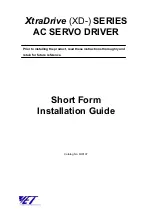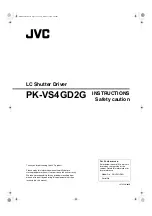
Xenus Plus Compact STO Manual
16-01553 Rev 00
Copley Controls
Page 16 of 31
6.6
Limitations and Necessary Risk Reductions
6.6.1 Electrical Isolation
The STO function does not provide electrical isolation between the drive and the motor.
Hazardous voltages may be present on the motor output terminal J2, even with the STO function activated.
6.6.2 DC Brush Motors
Failure of an IGBT in the outputs of the drive that renders the IGBT a virtual short-circuit might result in
continuous torque/force production in a DC motor. Unlike brushless motors that limit rotation to one half of an
electrical cycle, a DC brush motor can rotate uncontrollably under a failed IGBT scenario. As result, the STO
function cannot be used with DC brush motors.
6.6.3 180 Degree Electrical Movement
In the event of IGBT failures in the
Xenus Plus Compact
output stage, unexpected motor movement of up to
180 electrical degrees can occur. It is the responsibility of the designer of the larger system to assess and
address any hazards that this unexpected movement could create.
6.6.4 Loads and Other Torque/Force Producing Sources
The STO function produces an uncontrolled stop of category 0 as described in IEC 60204-1.
Any motor that is moving when the STO function is activated will coast to a stop unless there are other forces
operating on the same load. The STO function only removes torque/force produced by current flow from the
drive to the associated motor. Torque/force created by gravity-influenced loads or other torque/force
producing components mechanically connected to the motor shaft cannot and will not be affected by the
drive STO function. It is the responsibility of the designer of the larger system to assess and address any
hazards arising from torque/force producing sources.
6.6.5 STO Input Signal Level
The STO inputs (STO-IN1, STO-IN2) can withstand input voltages to 60V in case of an overvoltage fault
condition. Therefore a constraint on the larger system is that the power supply used to drive the STO inputs
must be a SELV or PELV type.
6.6.6 Control Modes and STO
The
Xenus Plus Compact
drive can control the position, velocity, and torque of motors while operating from a
number of control sources. But it can only do this when the STO function is inactive. And, while the digital
control core and firmware of the drive can observe the state of the STO function, it cannot interact with, or
exercise any control over the STO function.
The STO function operates completely independently of the control core of the drive and is
implemented entirely in hardware. It does not depend on the control core for its operation and the
control core of the drive has no control over the STO function.
















































